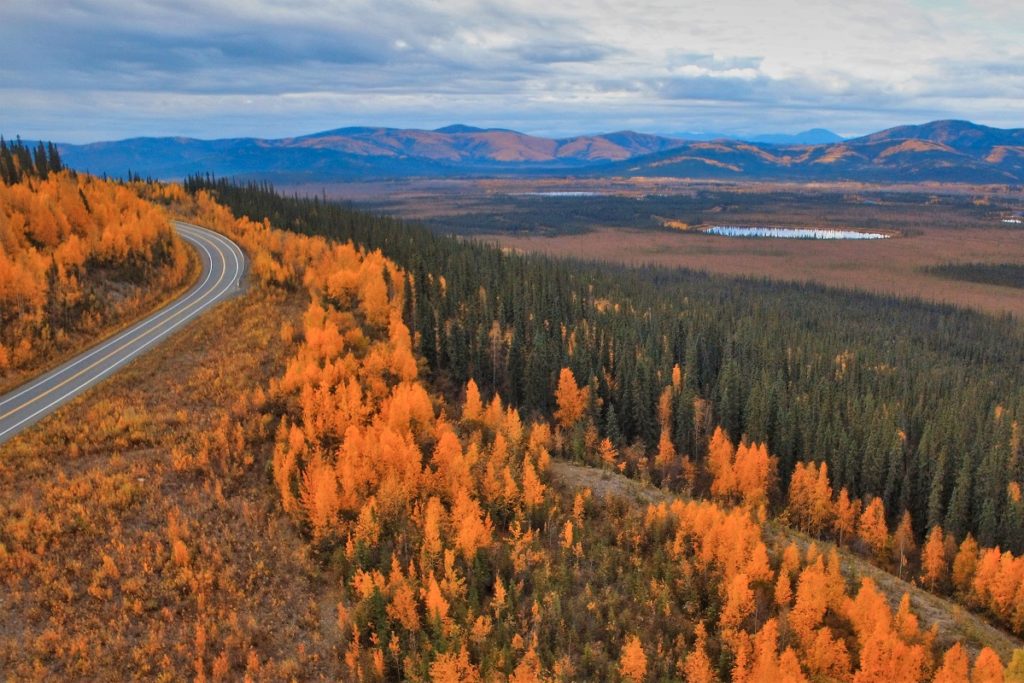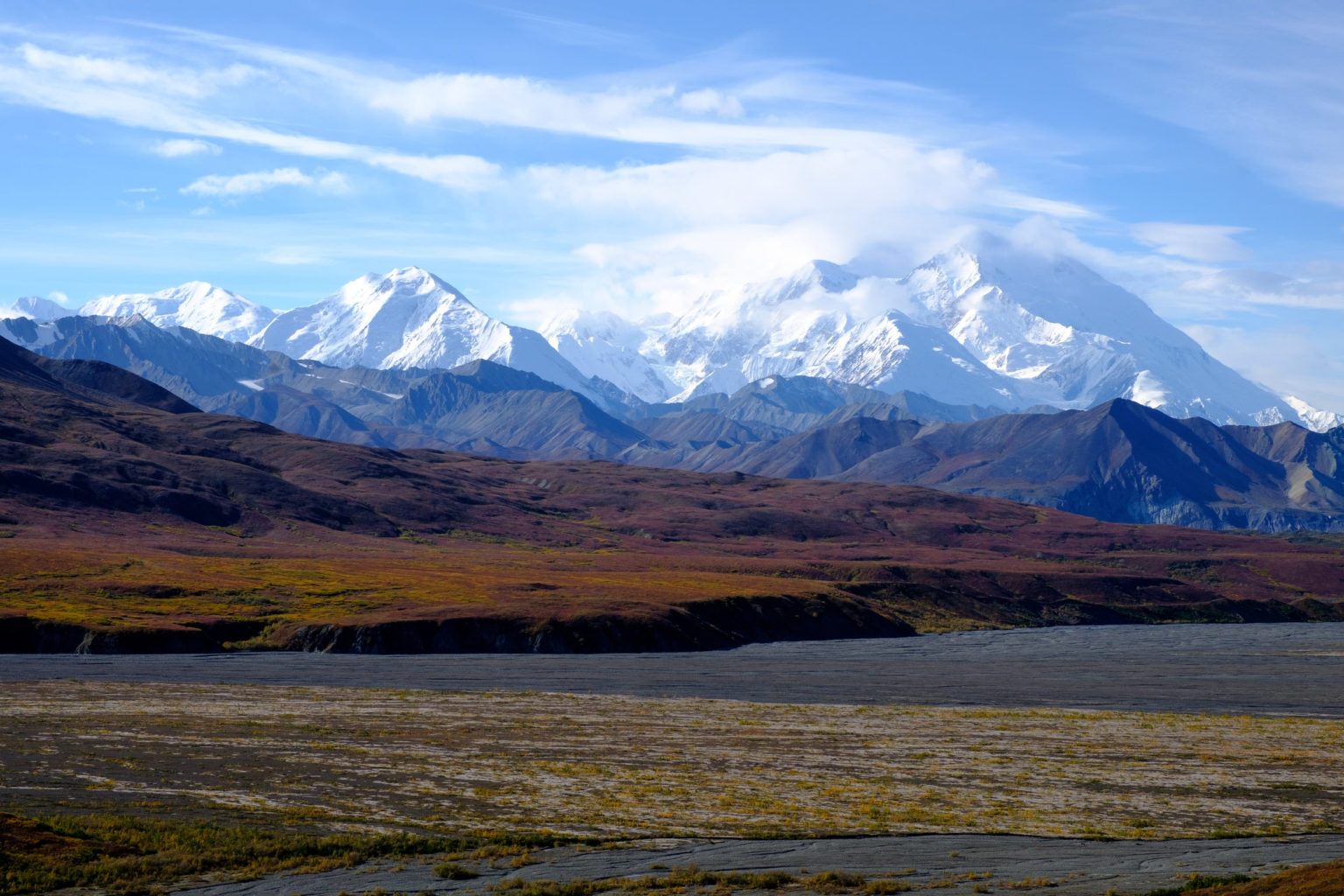Tips for taking the road less traveled: Alaska edition

When thinking about potential road trips, many of us confine our imaginations to the lower 48 states. But if you’re looking for backwoods travel opportunities, you’ll hit the mother lode if you head north to Alaska.
Cover photo: The Alaska Highway in it’s fall colors. (Mike’s Alaska Travels, Flickr CC)
Tips for Taking the Road Less Traveled: Alaska Edition
By Molly Barnes, Digital Nomad Life
When thinking about potential road trips, many of us confine our imaginations to the lower 48 states. But if you’re looking for backwoods travel opportunities, you’ll hit the mother lode if you head north to Alaska.
It’s easy to forget that Alaska has more land to explore than any other state. You may have to be selective about where (and when) you travel, but that makes the adventure that much more, well, adventurous.
There are more than 14,000 miles of public roads in Alaska, and many of them travel through national parks and forests. If you’re considering a road trip to the 49th state — and you definitely should — then here are some ideas that will help you plan a fantastic visit.
How to get there
This is pretty simple, actually. Traveling to Anchorage or Juneau by air or sea is most common, but if you’re looking for a road trip, you can access Alaska’s highway system from the lower 48 states by way of the aptly named Alaska Highway.
Once you cross the U.S.-Canada border, it’s off to Dawson Creek, British Columbia, and the starting point of the Alaska Highway. From there, it’s nearly 1,400 miles to Delta Junction, Alaska (about 100 miles south of Fairbanks), via Whitehorse, Yukon. If you plan on heading to Anchorage or Valdez, however, you’ll want to get off the highway and head south as soon as you reach Tok, Alaska, the first major community you’ll visit once you cross the border — from Tok, it’s just over a 300 mile drive to Anchorage.

It’s easy to forget how truly massive this region is, especially if you’re used to the East Coast, where you can travel through a few states in a few hours. In this case, plan on taking several days to get through British Columbia and the Yukon — longer if you pause along the way to hike or seek out photos for your scrapbook. (And trust me, you’ll want to take your camera, or at least your smartphone.)
How to prepare
Because Alaska offers a more isolated travel experience than other places, it’s important to plan your trip in advance. This is true whether you’ll be traveling to Alaska from afar or you’re a resident looking to explore your home turf. The state is vast, and the weather can make any form of travel more difficult and dangerous.
If you choose to drive, you’ll be able to experience much of Alaska’s beauty up close. Just be sure to map out your journey ahead of time so you know when and where to fill up with gas, where you’re going to stay, and what road conditions you’re likely to encounter. The state of Alaska has a great website called 511.alaska.gov that can give you an idea of what to expect in terms of roadwork, closures, weather incidents, etc.

You’ll also want to prepare your car with the standard oil change, tuneup, filter change and brake check. Make sure your wiper blades are functioning properly, and be sure to top off your antifreeze.
It’s especially important to make sure your tires are in good condition. Keep them inflated at the proper level (lower temperatures mean lower tire pressure), and check for low tread, cracks and bulges that could put you at risk for a tire blowout.
Make sure you’ve put together a budget for your trip that includes plenty of money for gasoline to account for the miles you’ll be traveling and the price of fuel in Alaska and Canada. Take cash and a credit card.
And learn about basic survival skills before you leave, just in case. If you’re off the beaten path, help could be hours (or even days) away.
When to go
As you might expect, a lot depends on the weather. You probably think of Alaska as a really cold place — and it can be. From November to March, you can expect subfreezing temperatures during the brief daylight hours and below-zero readings at night.
Fun fact: The lowest temperature ever recorded in Alaska (and the United States) was minus-79.8 degrees Fahrenheit at Prospect Creek in 1971. That’s pretty close to the center of Alaska, northwest of Fairbanks.
But temperatures are more bearable in spring and fall, with lows near freezing and highs in the upper 40s. In summer, you can expect the mercury to reach around 70 (sometimes higher) in daylight hours, which last 19½ hours in Anchorage and around the clock north of Fairbanks at the summer solstice.
What to take
Deciding what clothing to pack will depend mostly on which season you’ll be traveling. In the cooler months, you’ll want to take along warm pieces like:
- Long underwear
- Snow pants
- A wool hat, scarf, and mittens
- A down jacket
- Waterproof winter boots
If you’re traveling in the summer, stock your suitcase with essentials to protect you from frequent rain, all-day (and night) sun, and bothersome insects:
- Rain jacket
- Light jackets for layering
- Hiking shoes or boots
- Moisture-wicking socks
- Sunglasses
- Eye mask
- Insect repellent

For your drive, you’ll want to take along snow tires, an ice scraper, snow brush, extra antifreeze, a collapsible shovel to keep in your trunk along with cat litter or rock salt (to help your tires gain traction if you get stuck), plus a rope or tow chain, and a blanket.
Add that to your normal-weather list of equipment that includes a tool kit, jack, gas can, jumper cables, flashlight (with spare batteries), and reflectors.
In addition to your GPS and travel apps, you’ll want to take along paper maps to help you navigate through places where you can’t get a signal. And don’t forget a good guide book! You can download a digital version or purchase a paper copy that includes itineraries, packing lists, and more.
Where to go
There’s a lot to see in Alaska, and you won’t be able to see it all in one trip. But a few places you might want to put on your list include:
- Denali National Park is home to the tallest mountain in North America (Denali at 20,320 feet, formerly known as Mt. McKinley).
- Kenai Fjords National Park gives you a glimpse into the ice age via the Harding Icefields and its nearly 40 glaciers.
- Skagway, Sitka, and the Klondike Gold Rush National Historical Park along the Inside Passage will take you on a journey through history, highlighting the trails and boomtowns of that gilded era.
- The Dalton Highway will take you all the way to the northern coastline at Prudhoe Bay. Be prepared for icy conditions, remote locations, and unpaved portions along the way.
- Tongass National Forest is America’s largest national forest, at approximately 17 million acres. Be sure to visit one of the area’s most famous attractions, the Mendenhall Glacier.


If you plan on hiking, be sure you abide by the rules of the trail, just as you would the rules of the highway.
There’s so much to see in Alaska (don’t forget the Northern Lights!). If you plan your trip well, you’re in for an experience you’ll never forget.
Learn more about Molly Barnes and her Digital Nomad Life here. The views expressed here are the writer’s and are not necessarily endorsed by Alaska Wilderness League. For more information on traveling and the coronavirus, contact the Centers for Disease Control and Prevention.
